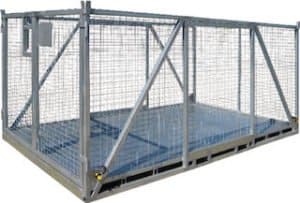On Thursday, 14 December 2006, a company was convicted and fined $17,500 after a worker suffered serious injuries when a steel beam fell on him while the centre of gravity was being established[1].
The company in question was deemed to have failed to identify all reasonable foreseeable hazards and assess (to minimise) risks.
The company failed to provide what was termed, “a safe system” for lifting beams using the mobile crane.
 A large goods cage (crane lift), such as this one, is capable of safely lifting 2 tonne of awkward or large products.
A large goods cage (crane lift), such as this one, is capable of safely lifting 2 tonne of awkward or large products.
The company was punished for failing to provide adequate training, information and instruction to the employee.
Risk and Hazard Assessment are vital for many workplaces, but especially in industrial, transportation and storage industries.
A risk assessment explores the likelihood, degree of exposure and consequences of a particular risk associated with an activity or job. Risk is defined as the probability (likelihood) of harm or damage occurring from exposure to a hazard, and the likely consequences of that harm or damage.
Hazard identification, meanwhile, explores the “what’s dangerous” side of workplace practices. A hazard is something that has the potential to cause human injury, ill health and/or damage to property (machinery and equipment) or to the environment. Hazard identification questions every aspect of a scenario and judges the safety of that scenario by asking, “What’s dangerous?”
This could mean assessing who is present, what equipment is in use, whether pedestrians have access, whether a speed limit is in place, checking load restraint, designating loading areas and exclusion areas, whether reversing vehicles can intrude, checking blind spots, considering the installation of barriers and much more.
That being said, basic hazard identification and risk assessment is not enough.
It is vital to implement key structural changes to your workplace, system and employee behaviour.
Workplace productivity and time efficiencies are of a high concern for all businesses, but (as we’ve said before on this very blog) speed and convenience often comes at the price of occupational health and safety or at the risk of a workplace injury.
Investing in key materials handling solutions is the best insurance against risk.
[1] Government of South Australia, Safework SA.
